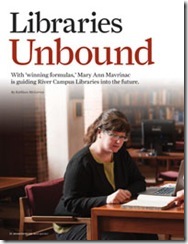 What started out as an interesting article about the papers of William Henry Seward being digitized at the University of Rochester turns into one about the changing nature of libraries, making it worth the read twice over:
What started out as an interesting article about the papers of William Henry Seward being digitized at the University of Rochester turns into one about the changing nature of libraries, making it worth the read twice over:
Cornell’s Kenney says that in the wake of the web, the role of libraries on campuses “isn’t as self-evident as it once was. It’s a more complex environment.”
The key to adapting, for librarians and users alike, is to focus on content rather than format, says Dimmock. “A book, a physical book, is a format. Is it the content that matters? Being a film librarian, I’ve always had to think about those issues. In my back room, I have 16 millimeter. I have laser discs. I have VHS. I have DVD—and now even DVD is dead. They’re just containers. It’s the content.”
And moving away from that materiality is “a new service model,” she says. “We’ve very much organized around collections, and we have to change the way we think about collections.” As digitization brings greater uniformity to libraries’ collections—publishers sell journals, databases, and other resources in bundles, much like cable companies do channels—rare books and manuscripts take a special place. “I think that the collections that are going to matter the most to libraries are the special collections, because those are the unique things,” says Dimmock.
While the Internet has made address-hunting trips to the library unnecessary, students’ need for guidance in navigating libraries’ resources is only growing more acute. Students today “have been using technology since they were toddlers,” says Toronto’s Alford, but they don’t necessarily understand how academic information searching works. “There’s extraordinary complexity of information access and discovery.”
Read the full article @ rochester.edu. (Thanks Dad)